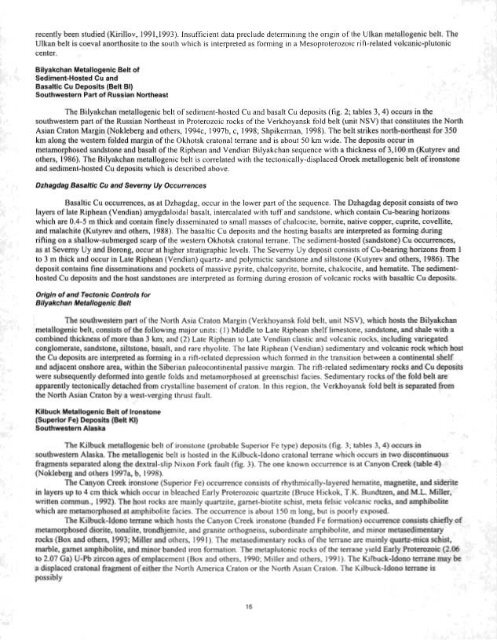Metallogenesis and Tectonics of the Russian Far East, Alaska, and ...
Metallogenesis and Tectonics of the Russian Far East, Alaska, and ...
Metallogenesis and Tectonics of the Russian Far East, Alaska, and ...
Create successful ePaper yourself
Turn your PDF publications into a flip-book with our unique Google optimized e-Paper software.
ecently been studied (Kirillov, 1991,1993). Insufficient data preclude determining <strong>the</strong> origin <strong>of</strong> <strong>the</strong> Ulkan melnllogenic belt. The<br />
Ulkan belt is coeval anorthosite to <strong>the</strong> south which is interpreted as forming in a Mesoproterozoic rift-related v~lcanic-plutonic<br />
cenler.<br />
BWyakohan Metallogedo Belt <strong>of</strong><br />
SedirnentSlosed Cu <strong>and</strong><br />
Basaltic Cu Deposlls (Belt 81)<br />
Sowhwegtern Part <strong>of</strong> <strong>Russian</strong> NoM~east<br />
The Bilyakchan metallagenic belt <strong>of</strong> sediment-hosted Cu <strong>and</strong> basalt Cu deposits (fig. 2; tables 3,4) occurs in <strong>the</strong><br />
southwestern part <strong>of</strong> <strong>the</strong><strong>Russian</strong> Nor<strong>the</strong>ast in Proterozoic rocks <strong>of</strong> <strong>the</strong> Verkhoyansk fold belt (unit NSV) that cbnztitutt~ <strong>the</strong> NoHh<br />
Asian Crato~ Margin (Nokleberg <strong>and</strong> o<strong>the</strong>rs, 1994c, 1997b, c, 1995; Shpikerman, 1998). The belt strikes north-nodetast for 350<br />
km along <strong>the</strong> westem foMed margin <strong>of</strong> <strong>the</strong> Okhotsk cratonal terrane <strong>and</strong> is about 50 km wide. The deposit3 occur in<br />
metamorphosed s<strong>and</strong>stone a d basalt <strong>of</strong> <strong>the</strong> Riphean <strong>and</strong> Vendian Bilyakchan sequence with a thiche-u <strong>of</strong> 3,100 m (Kutyrev <strong>and</strong><br />
o<strong>the</strong>rs, 1986). The Bilyakchan metallogenic belt is correlated with <strong>the</strong> tectonically-displaced Oroek metalkogenic belt <strong>of</strong> ironslone<br />
<strong>and</strong> sedimenthosted Cu deposits which is described above.<br />
Dzhegdag B ~Iffc Cu <strong>and</strong> Severny Uy Occurrences<br />
Basaltic Cu occurrences, as at Dzhagdag, occur in <strong>the</strong> lower part <strong>of</strong> <strong>the</strong> sequence. The Dzfiagdag deposit c~sisls <strong>of</strong> two<br />
layers <strong>of</strong> late Ripheam (Vendian) arnygdaloidal basalt, intercalated with tuff <strong>and</strong> s<strong>and</strong>stone, which contain (3-bearing horizons<br />
which are 0.4-5 m thick <strong>and</strong> contain finely disseminated to small masses <strong>of</strong> chalcocite, bornite, native copper, cuprite, covellite,<br />
<strong>and</strong> malachite (Kutyrev md o<strong>the</strong>rs. 1988). The basaltic Cu deposits <strong>and</strong> <strong>the</strong> hosting basalts are interpreted aa forming during<br />
rifting on a shallow-submerged scarp <strong>of</strong> <strong>the</strong> western Okhotsk cratonal terrane. The sediment-hosted (sendstone) Cu occurrences,<br />
as at Severny Uy <strong>and</strong> Borong, occur at higher stratigraphic levels. The Severny Uy deposit consists <strong>of</strong> Cu-bearing horizons &om I<br />
to 3 m thick <strong>and</strong> occur in Late Riphean (Vendian) quartz- <strong>and</strong> polymictic s<strong>and</strong>stone <strong>and</strong> siltstone (Kulyrev <strong>and</strong> otkers, 1986). The<br />
deposit contains fine disseminations <strong>and</strong> pockets <strong>of</strong> massive pyrite, chalcopyrite, bornite, chalcocite, <strong>and</strong> hematite. The sedimenthosted<br />
Cu deposits <strong>and</strong> tbe bast s<strong>and</strong>stones are interpreted as forming during erosion <strong>of</strong> volcanic rocks with basaltic Cu dm&. Origin <strong>of</strong> end Tectonic Contrdf for<br />
Bilyakchn Metallogenic Belt<br />
The southwestern par! <strong>of</strong> <strong>the</strong> North Asia Craton Margin (Verkhoyansk fold belt, unit NSV), which boa <strong>the</strong> Bilyakchan<br />
metaligenic belt., consisls <strong>of</strong> <strong>the</strong> following major units: (1) Middle to Late Riphean shelf limestone, s<strong>and</strong>stone, Pnd shale with a<br />
cambiead thickness <strong>of</strong> more thiln 3 km; <strong>and</strong> (2) Late Riphean to Late Vendian clastic <strong>and</strong> volcanic rocks, mduding variegated<br />
conglomerate, srtndarona, silbtonc, basalt, <strong>and</strong> rare rhyolite. The late Riphean (Vendian) sedimentary <strong>and</strong> volcanic rockwMcb host<br />
<strong>the</strong> Cu &posh are interpreted as fming in a rift-related depression which formed in <strong>the</strong> transition between a continental shelf<br />
<strong>and</strong> adjacent onshore am, with <strong>the</strong> Siberian paleocontinental passive margin. The rift-related sedimentary cocks <strong>and</strong> Cu deposits<br />
were suhequtntly deformed into gentle folds <strong>and</strong> metamorphosed at greenschist facies. Sedimentary rocks <strong>of</strong> <strong>the</strong> fold belt are<br />
epparently tectonically detached fiom crystalline basement <strong>of</strong> craton. In this region, <strong>the</strong> Verkhoyansk fold kllis separated from<br />
he North Asian Craton by a west-verging thrust fault.<br />
Kllbuck MsWtqpnlc Eelt <strong>of</strong> Ironstone<br />
{Superior Fe) Deposits f Belt KI)<br />
SouthweSkrn Alwka<br />
The Kilbuck metallogenic belt <strong>of</strong> ironstone (probable Superior Fe type) deposits (fig. 3; tables 3,4) occurs in<br />
southwestern <strong>Alaska</strong>. The metallogenic belt is hosted in <strong>the</strong> Kilbuck-Idono cratonal terrane which occurs in two dif~~atinuous<br />
6agments separated along <strong>the</strong> dextral-slip Nixon Fork fault (fig. 3). The one known occurrence is at Canyon Cnak (table 4)<br />
(Noldebetg aad o<strong>the</strong>rs 19974 b, 1998).<br />
The Canyon Creek ironstone (Superior Fe) occurrence consists <strong>of</strong> rhythmically-layered hematite, magsahte, <strong>and</strong> siderite<br />
in layers up lo 4 cm thick which occur in bleached Early Proterozoic quartzite (Bruce Hickok, T.K. Bindtzen, <strong>and</strong>ML. Miller,<br />
written commun., 1992). The host rocks are mainly quartzite, garnet-biotite schist, meta felsic volcanic rocks, <strong>and</strong> amphibolite<br />
which are me~orphosed at amphibolite facies. The occurrence is about 150 m long, but is poorly exposed.<br />
The Wbuck-Idono terrane which hosts <strong>the</strong> Canyon Creek ironstone (b<strong>and</strong>ed Fe formation) occurrence wnsiats chicfly <strong>of</strong><br />
rnctmnorpbosed diorite, tonalite, trondhjemite, <strong>and</strong> granite orthogneiss, subordinate amphibolite, <strong>and</strong> minor metsedimentary<br />
roch (Box <strong>and</strong> o<strong>the</strong>rs, 1993; Miller <strong>and</strong> o<strong>the</strong>rs, 1991). The metasedimentary rocks <strong>of</strong> <strong>the</strong> terrane are mainly quartz-mica schist,<br />
marble, garnet amphlbolltc, <strong>and</strong> minor b<strong>and</strong>ed iron formation. The metaplutonic rocks <strong>of</strong> <strong>the</strong> terrane yield Early Proterozoit (2.06<br />
to 2.07 Ga) U-Pb zirconages <strong>of</strong> emplacement (Box <strong>and</strong> o<strong>the</strong>rs, 1990; Miller <strong>and</strong> o<strong>the</strong>rs, 1991). The Kilbuck-lho terrmu may be<br />
a displaced cratodd kagment <strong>of</strong> ei<strong>the</strong>r <strong>the</strong> North America Craton or <strong>the</strong> North Asian Craton. The Kilbuck-ldono t m is<br />
wsibly
















